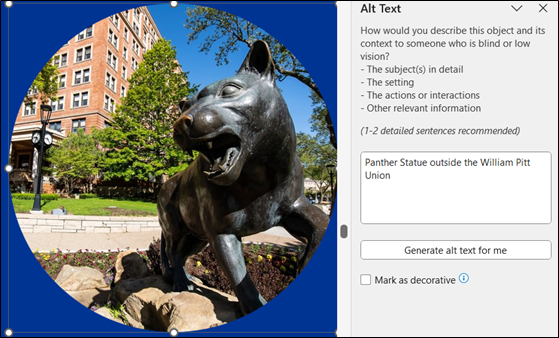Alternative text should be provided for all non-text content including photos, graphs, and icons. It should be succinct but descriptive of the purpose of the image.
What does this mean?
Alternative text, or more commonly alt text, is a written alternative to non-text content in digital spaces. It is most frequently used for images on websites, documents, and Canvas pages. Alt text informs blind users about the images that they cannot see and alt text will show instead of loading images for slower internet connections. As such, alt text should be descriptive of the relevant content of the image without being too long. Usually one to two sentences are fine.
Alt text should be relevant to the context in which the image is found. For example, in the image below, the given alt text is likely to be sufficient if the image was on the Pitt admissions website. However, if this image were presented in an art class Canvas page, the alt text could be totally different and discuss important aspects about the sculpture’s material composition or artistic style.
Application

When writing alt text, consider what is most important in the image. Why was it included on this page? Try to convey that through the alt text. For more insight about how to write good quality alt text, consider checking out the Alt Text as Poetry project.
Remember not to write more than a couple of sentences. Also, there is no need to say that something is “an image of…” – assistive technology will inform the user that it is an image automatically.
Microsoft Office
To add alt text in Word, PowerPoint, Outlook, and Excel, follow the instructions below.
- Right-click on the image and select “View Alt Text”. A sidebar menu will open.
- Enter the appropriate alt text in the provided box.
If an image is merely decorative and does not add meaning to the content, select the “Mark as decorative” check box. This lets the reader know that the alt text was not forgotten. Be sure to only use this for purely decorative elements such as a section dividing line or other flourishes.
Drupal Websites
To add alt text in Drupal, follow the instructions below. Alt text is now required in Drupal so you should see an error if it is missing from any images.
- Add your image to the webpage editor body or the header.
- Enter the appropriate alt text in the provided box that appears.
If an image is merely decorative and does not add meaning to the text, select the “Decorative image” slider. This lets the reader know that the alt text was not forgotten. Be sure to only use this for purely decorative elements such as a section dividing line or other flourishes.
Charts and Graphs
Charts and graphs also require alt text, though the recommendations differ slightly. The main ideas of succinct but relevant description and conveying the purpose still apply. However, alt text for data will usually be more detailed and therefore a bit longer.
Unless your data set is very small (about 5 or less data descriptors), we do not want to list out every data point or trend in the alt text. We still want to limit the alt text to no more than 4 sentences approximately. The best practice is to describe what the dataset is about, call out the two most prevalent trends in the graph, and then summarize the rest of the data in a final sentence. This could look like calling out the two largest percentages in a pie chart or describing the relationships between trendlines on a line graph. The interpretation is up to you. In the same way that you would write an image’s alt text, ask yourself “What is the main purpose for including this image? What do I want viewers to understand from this image?”. This may help you find your two main trends.
Additionally, it is best to also include either the full data table below or a link to the full data set along with your data visualization. This is because a table is generally more accessible for assistive technology users to view data and it allows them to understand the full details of complex datasets if they so choose.
If you need further assistance with data visualization accessibility, please reach out to accessibility@pitt.edu.
Impact
Alt text is critically important for disabled users to get the full experience of your content. This is especially true in higher education when images are frequently used to depict complex ideas in the classroom or illicit a particular response in outreach articles. Without alt text, the key context that images provide is completely missing for blind and low vision users.
But alt text is not just for disabled users, it can also benefit those who experience slower internet connections that cannot fully load images. This is the norm for many in rural areas but could potentially impact anyone at any time due to outages or overcrowded signals.
